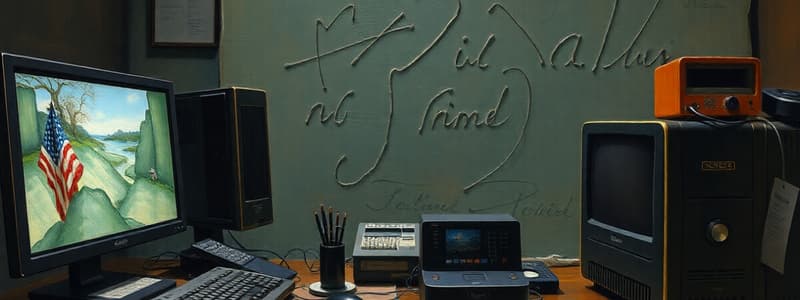Podcast
Questions and Answers
What is the primary purpose of system software?
What is the primary purpose of system software?
- To manage interactions between hardware and application software (correct)
- To initiate and manage internet connections
- To enable multimedia playback on the computer
- To perform user-specific tasks such as document editing
Which of the following best defines application software?
Which of the following best defines application software?
- Software designed to enhance system security and performance
- Software that performs tasks unrelated to system functionality (correct)
- Software that operates independently of the user’s input
- Software used solely for hardware diagnostics and repairs
In what context would you find a software suite?
In what context would you find a software suite?
- A collection of programs that share the same user interface (correct)
- A group of unrelated software applications installed together
- A set of utilities for basic system maintenance
- A software tool for managing storage devices directly
Which of the following statements correctly differentiates system software from application software?
Which of the following statements correctly differentiates system software from application software?
Which of the following is an example of application software?
Which of the following is an example of application software?
What is a significant characteristic of user interaction with system software?
What is a significant characteristic of user interaction with system software?
Which aspect typically describes the dependency relationship between application software and system software?
Which aspect typically describes the dependency relationship between application software and system software?
What unit of measure is typically used to quantify the capacity of data storage in relation to system software?
What unit of measure is typically used to quantify the capacity of data storage in relation to system software?
How does user interaction differ between system software and application software?
How does user interaction differ between system software and application software?
Which of the following best describes the dependency relationship between system software and application software?
Which of the following best describes the dependency relationship between system software and application software?
Flashcards
System software
System software
Software that manages and controls computer hardware and software resources.
Application software
Application software
Software designed for specific tasks, such as word processing or web browsing.
Example of system software
Example of system software
Operating Systems like Windows, Linux, or Unix.
Example of application software
Example of application software
Signup and view all the flashcards
Difference between system and application software
Difference between system and application software
Signup and view all the flashcards
Laser Printer
Laser Printer
Signup and view all the flashcards
Inkjet Printer
Inkjet Printer
Signup and view all the flashcards
Software
Software
Signup and view all the flashcards
Study Notes
Introduction to Computers
- A computer is a machine programmed to perform arithmetic and logical operations.
- Computer systems can include hardware, operating systems, software, and peripherals.
- Networks or clusters of computers can function together.
- Early computers used vacuum tubes, moving to transistors and integrated circuits.
- Computers are used in a wide range of applications, from simple devices to complex systems.
- Early forms of calculation include the abacus and mechanical devices.
- The digital electronic calculators began during the 20th century.
Computer Components
- Computer hardware includes physical components like monitors, keyboards, mice, hard drives, etc.
- Software comprises sets of instructions for the computer to execute tasks.
- Different types of computers include supercomputers, mainframes, minicomputers, workstations, personal computers, laptops, netbooks, mobile devices, and tablets.
- The CPU (Central Processing Unit) is the "brain" of a computer.
- The ALU (Arithmetic Logic Unit) performs calculations and comparisons.
- The CU (Control Unit) manages and coordinates computer functions.
- RAM (Random Access Memory) is temporary storage for active data and instructions.
- ROM (Read-Only Memory) is permanent storage for essential instructions.
Input Devices
- These devices provide data to the computer.
- Examples include keyboards, mice, touchscreens, scanners, microphones, cameras, and joysticks.
- Input devices translate data into a format recognizable by the computer.
Output Devices
- These devices display or communicate the results of processing.
- Examples include monitors, printers, speakers, projectors, and plotters.
- They convert computer data into a form understandable by humans.
Types of Software
- System software manages the computer's hardware and operations.
- Application software performs specific tasks.
- Examples of system software include operating systems (Windows, Linux, macOS).
- Examples of application software include web browsers, word processors, spreadsheets, and games.
Data, Information, and Knowledge
- Data are raw facts and figures.
- Information is processed data that provides context and meaning.
- Knowledge is understanding gained from information and experience.
Computer Characteristics
- Speed: Computers execute tasks at high speeds.
- Accuracy: High levels of precision in calculations.
- Diligence: Continuous operation without fatigue.
- Storage Capability: Ability to store large amounts of information.
- Versatility: Ability to handle various tasks.
Computer Viruses
- Viruses are malicious software that can damage or disrupt computer systems.
- Email viruses spread through email attachments.
- Other forms of threats include Trojan horses, and worms.
- It's important to have antivirus and anti-malware programs, and to use secure practices when handling data.
Computer Storage
- Storage measures are in units of bits, bytes, kilobytes, megabytes, gigabytes, and terabytes.
Studying That Suits You
Use AI to generate personalized quizzes and flashcards to suit your learning preferences.




